
A | B | C | D | E | F | G | H | CH | I | J | K | L | M | N | O | P | Q | R | S | T | U | V | W | X | Y | Z | 0 | 1 | 2 | 3 | 4 | 5 | 6 | 7 | 8 | 9
The Indian Navy is the maritime branch of the Indian Armed Forces. The President of India is the Supreme Commander of the Indian Navy. The Chief of Naval Staff, a four-star admiral, commands the navy. As a blue-water navy, it operates significantly in the Persian Gulf Region, the Horn of Africa, the Strait of Malacca, and routinely conducts anti-piracy operations and partners with other navies in the region. It also conducts routine two to three month-long deployments in the South and East China seas as well as in the western Mediterranean sea simultaneously.
The primary objective of the navy is to safeguard the nation's maritime borders, and in conjunction with other Armed Forces of the union, act to deter or defeat any threats or aggression against the territory, people or maritime interests of India, both in war and peace. Through joint exercises, goodwill visits and humanitarian missions, including disaster relief, the Indian Navy promotes bilateral relations between nations.
As of June 2019, the Indian Navy has 67,252 active[5] and 75,000 reserve personnel in service and has a fleet of 150 ships and submarines, and 300 aircraft.[6][7] As of September 2022, the operational fleet consists of 2 active aircraft carriers and 1 amphibious transport dock, 4 landing ship tanks, 8 landing craft utility, 12 destroyers, 12 frigates, 2 ballistic missile submarines, 16 conventionally-powered attack submarines, 18 corvettes, one mine countermeasure vessel, 4 fleet tankers and numerous other auxiliary vessels, small patrol boats and sophisticated ships. It is considered as a multi-regional power projection blue-water navy.[8][9]
History

Early Maritime History
This history section needs additional citations for verification. (November 2023) |


The maritime history of India dates back 6,000 years to the pre-Indus Valley civilisation.[10] A Kutch mariner's log book from 19th century recorded that the first tidal dock in India was built at Lothal around 2300 BC during the Indus Valley Civilisation, near the present day harbour of Mangrol on the Gujarat coast. The Rig Veda credits Varuna, the Hindu god of water and the celestial ocean,[11] with knowledge of the ocean routes and describes the use of ships having hundred oars in the naval expeditions by Indians. There are also references to the side wings of a ship called Plava, which stabilise the vessel during storms. Plava are considered to be the precursors of modern-day stabilisers.[12]
Alexander the Great, during his campaigns in India, built a harbour at Patala. His army retreated to Mesopotamia using ships built at Sindh. In the period after his conquest, records show that the Emperor of Maurya Empire, Chandragupta Maurya, as a part of his war office, established an Admiralty Division. Many historians from ancient India recorded Indian trade relations. Indian trade reached Java and Sumatra. There were also references to the trade routes of countries in the Pacific and Indian Ocean. India also had trade relations with the Greeks and the Romans. At one instance Roman historian Gaius Plinius Secundus mentioned Indian traders carrying away large masses of gold and silver from Rome, in payment for skins, precious stones, clothes, indigo, sandalwood, herbs, perfumes, and spices.[12]
During 5–10 AD, Kalinga conquered Western Java, Sumatra and Malaya. The Andaman and Nicobar Islands served as an important halt point for trade ships en route to these nations and as well as China.
Middle Ages
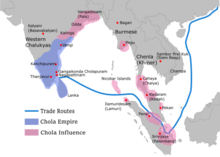
Medieval Empires in the Indian subcontinent further developed their naval forces. During 844–848 AD the daily revenue from these nations was expected to be around 200 maunds (8 tonnes (7.9 long tons; 8.8 short tons)) of gold. During 984–1042 AD, under the reign of Raja Raja Chola I, Rajendra Chola I and Kulothunga Chola I, a naval expedition by the Chola dynasty captured parts of Burma, Sumatra, Sri Lanka, and Malaya, and simultaneously repressed pirate activities by Sumatran warlords.[12][13]
... built of fir timber, having a sheath of boards laid over the planking in every part, caulked with oakum and fastened with iron nails. The bottoms were smeared with a preparation of quicklime and hemp, pounded together and mixed with oil from a certain tree which is a better material than pith
During 14th and 15th centuries, Indian shipbuilding skills and their maritime ability was sophisticated enough to produce ships with a capacity to carry over hundred men. Ships also had compartments included in their design, so that even if one compartment was damaged, the ship would remain afloat. These features of ships were developed by Indians even before Europeans were aware of the idea.[12]
Decline
By the end of 15th century Indian naval power had started to decline, and had reached its low by the time the Portuguese entered India. Soon after they set foot in India, the Portuguese started to seize all Asian vessels not permitting their trade. Amidst this, in 1529, a naval war at Bombay Harbour resulted in the surrender of Thane, Karanja, and Bandora. By 1534, the Portuguese took complete control over Bombay Harbour. The Zamorin of Calicut challenged the Portuguese trade when Vasco da Gama refused to pay the customs levy as per the trade agreement. This resulted in two major naval wars, the first one—Battle of Cochin, was fought in 1504, and the second engagement happened four years later off Diu. Both these wars exposed the weakness of Indian maritime power and simultaneously helped the Portuguese to gain mastery over the Indian waters.[12] However, in 1526 the Zamorin launched a siege on the Portuguese forts in Calicut, successfully eliminating Portuguese influence in the city.[14]
Later revival
In the later seventeenth century Indian naval power observed revival. The Mughal Empire maintained a significant navel fleet although it was the weakest branch of the military.[15] The Navy mainly patrolled coastal areas. The navy was active in the Siege of Hooghly and the Anglo-Mughal War. [16] [17] One of the best-documented naval campaign of the Mughal empire were provided during the conflict against kingdom of Arakan, where in December 1665, Aurangzeb dispatched Shaista Khan, his governor of Bengal to command 288 vessels and more than 20,000 men to pacify the pirate activities within Arakan territory and to capture Chittagong,[18]
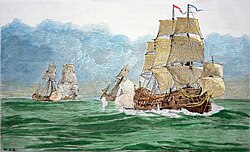
Empress Mariam-uz-Zamani maintained large fleets of trade ships including the Rahīmī and Ganj-i-Sawai.[19][20] The Rahimi was the largest of the Indian ships trading in the Red Sea.[21] After being sacked by pirates, this ship was replaced by the Ganj-i-Sawa. This ship was eventually scaked by English Pirate Henry Every.[22]

The Maratha Confederacy had a significant coastal navy. The alliance of the Moghuls and the Sidis of Janjira was marked as a major power on the west coast. On the southern front, the 1st Sovereign of the Maratha Empire, Chhatrapati Shivaji Maharaj, started creating his own fleet. His fleet was commanded by notable admirals like Sidhoji Gujar and Kanhoji Angre. The Maratha Navy under the leadership of Angre kept the English, Dutch and Portuguese away from the Konkan coast. However, the Marathas witnessed remarkable decline in their naval capabilities following the death of Angre in 1729.[12]
1612 origins to independence
The origins of the Indian Navy date to 1612, when an English vessel under the command of Captain Best encountered the Portuguese. Although the Portuguese were defeated, this incident along with the trouble caused by the pirates to the merchant vessels, forced the British to maintain fleet near Surat, Gujarat. East India Company (HEIC) formed a naval arm, and the first squadron of fighting ships reached the Gujarat coast on 5 September 1612. Their objective was to protect British merchant shipping off the Gulf of Cambay and up the Narmada and Tapti rivers. As the HEIC continued to expand its rule and influence over different parts of India, the responsibility of Company's Marine increased too.[23]
Over time, the British predominantly operated from Bombay, and in 1686, the HEIC's naval arm was renamed the Bombay Marine. At times the Bombay Marine engaged Dutch, French, Maratha, and Sidi vessels. Much later, it was also involved in the First Anglo-Burmese War of 1824. In 1834, the Bombay Marine became Her Majesty's Indian Navy. The Navy saw action in the First Opium War of 1840 and in the Second Anglo-Burmese War in 1852. Due to some unrecorded reasons, the Navy's name reverted to the Bombay Marine from 1863 to 1877, after which it was named Her Majesty's Indian Marine. At that time, the Marine operated in two divisions—the Eastern Division at Calcutta under the Superintendent of Bay of Bengal, and the Western Division at Bombay Superintendent of Arabian Sea.[23] In 1892 the Marine was renamed the Royal Indian Marine, and by the end of the 19th century it operated over fifty ships. The Marine participated in World War I with a fleet of patrol vessels, troop carriers, and minesweepers. In 1928, D. N. Mukherji was the first Indian to be granted a commission, in the rank of an Engineer Sub-lieutenant. Also in 1928, the RIM was accorded combatant status, which entitled it to be considered a true fighting force and to fly the White Ensign of the Royal Navy.[24] In 1934, the Marine was upgraded to a full naval force, thus becoming the Royal Indian Navy (RIN), and was presented the King's colours in recognition of its services to the British Crown.[23]
During the early stages of World War II, the tiny Royal Indian Navy consisted of five sloops, one survey vessel, one depot ship, one patrol vessel and numerous assorted small craft; personnel strength was at only 114 officers and 1,732 sailors.[25] The onset of war led to an expansion in numbers of vessels and personnel. By June 1940, the navy had doubled its number in terms of both personnel and material, and expanded nearly six times of its pre-war strength by 1942.[26] The navy was actively involved in operations during the war around the world and was heavily involved in operations around the Indian Ocean, including convoy escorts, mine-sweeping and supply, as well as supporting amphibious assaults.[23]
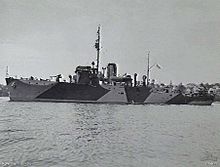
When hostilities ceased in August 1945, the Royal Indian Navy had expanded to a personnel strength of over 25,000 officers and sailors. Its fleet comprised seven sloops, four frigates, four corvettes, fourteen minesweepers, sixteen trawlers, two depot ships, thirty auxiliary vessels, one hundred and fifty landing craft, two hundred harbour craft and several offensive and defensive motor launches.[27] During World War II the Navy suffered two hundred and seventy five casualties—twenty seven officers, two warrant officers and 123 ratings killed in action, two ratings missing in action and a further 14 officers, two warrant officers and 123 ratings wounded.[28] For their role in the war, the officers and ratings of the Navy received the following honours and decorations—a KBE (Mil.), a knighthood, a CB (Mil.), 10 CIEs, two DSOs, a CBE, 15 DSCs, an OBE, 28 DSMs, eight OBIs, two IOMs, 16 BEMs, 10 Indian Defence Service Medals, a Royal Humane Society Medal, 105 mentions in dispatches and 118 assorted commendations.[29] Immediately after the war, the navy underwent a rapid, large-scale demobilisation of vessels and personnel.
From the inception of India's naval force, some senior Indian politicians had voiced concerns about the degree of "Indianisation" of the Navy and its subordination to the Royal Navy in all important aspects.[30] On the eve of WWII, the RIN had no Indian senior line officers and only a single Indian senior engineer officer.[31] Even by the war's end, the Navy remained a predominantly British-officered service; in 1945, no Indian officer held a rank above engineer commander and only a few Indian officers in the executive branch held substantive senior line officer rank.[32] This situation, coupled with inadequate levels of training and discipline, poor communication between officers and ratings, instances of racial discrimination and the ongoing trials of ex-Indian National Army personnel ignited the Royal Indian Navy mutiny by Indian ratings in 1946.[33] A total of 78 ships, 20 shore establishments and 20,000 sailors were involved in the strike, which spread over much of India. After the strike began, the sailors received encouragement and support from the Communist Party in India; unrest spread from the naval ships, and led to student and worker hartals in Bombay. The strike ultimately failed as the sailors did not receive substantial support from either the Indian Army or from political leaders in Congress or the Muslim League.[34] On 21 July 1947, H.M.S. Choudhry and Bhaskar Sadashiv Soman, both of whom would eventually command the Pakistani and Indian Navies, respectively, became the first Indian RIN officers to attain the acting rank of captain.[35]
Independence to the end of the 20th century
Following independence and the partition of India on 15 August 1947, the RIN's depleted fleet of ships and remaining personnel were divided between the newly independent Dominion of India and Dominion of Pakistan. 21 per cent of the Navy's officer cadre and 47 per cent of its sailors opted to join the portion of the fleet which became the Royal Pakistan Navy. The Indian share of the Navy consisted of 32 vessels along with 11,000 personnel. Effective from the same date, all British officers were compulsorily retired from the Navy and its reserve components, with Indian officers being promoted to replace British senior officers.[36] However, a number of British flag and senior officers were invited to continue serving in the RIN,[37] as only nine of the Navy's Indian commissioned officers had more than 10 years' service, with the majority of them only having served from five to eight years.[38] Rear Admiral John Talbot Savignac Hall headed the Navy as its first Commander-in-Chief (C-in-C) post-Independence.[23] In January 1948, D.N. Mukherji, the first Indian officer in the RIN, became the first Indian to be promoted acting engineer captain.[39] In May 1948, Captain Ajitendu Chakraverti became the first Indian officer to be appointed to the rank of commodore.[40] When India became a republic on 26 January 1950, the Royal prefix was dropped and the name Indian Navy was officially adopted. The prefix for naval vessels was changed from His Majesty's Indian Ship (HMIS) to Indian Naval Ship (INS).[23] At the same time, the imperial crown in insignia was replaced with the Lion Capital of Ashoka and the Union Jack in the canton of the White Ensign was replaced with the Indian Tricolour.[41]
By 1955, the Navy had largely overcome its post-Independence personnel shortfalls.[36] During the early years following independence, many British officers continued to serve in the Navy on secondment from the Royal Navy, due to the post-Independence retirement or transfer of many experienced officers to the Royal or the Pakistan navies.[36] The first C-in-C of the Navy was Admiral Sir Edward Parry who took over from Hall in 1948 and handed over to Admiral Sir Charles Thomas Mark Pizey in 1951. Admiral Pizey also became the first Chief of the Naval Staff in 1955, and was succeeded by Vice Admiral Sir Stephen Hope Carlill the same year[23] The pace of "Indianising" continued steadily through the 1950s. By 1952, senior Naval appointments had begun to be filled by Indian officers,[42] and by 1955, basic training for naval cadets was entirely conducted in India.[43] In 1956, Ram Dass Katari became the first Indian flag officer, and was appointed the first Indian Commander of the Fleet on 2 October.[44] On 22 April 1958, Vice Admiral Katari assumed the command of the Indian Navy from Carlill as the first Indian Chief of Staff of the Indian Navy.[45] With the departure in 1962 of the last British officer on secondment to the Navy, Commodore David Kirke, the Chief of Naval Aviation, the Indian Navy finally became an entirely Indian service.[46]
The first engagement in action of the Indian Navy was against the Portuguese Navy during the liberation of Goa in 1961. Operation Vijay followed years of escalating tension due to Portuguese refusal to relinquish its colonies in India. On 21 November 1961, Portuguese troops fired on the passenger liner Sabarmati near Anjadip Island, killing one person and injuring another.[47] During Operation Vijay, the Indian Navy supported troop landings and provided fire support. The cruiser INS Delhi sank one Portuguese patrol boat,[48] while frigates INS Betwa and INS Beas destroyed the Portuguese frigate NRP Afonso de Albuquerque.[49] The 1962 Sino-Indian War was largely fought over the Himalayas and the Navy had only a defensive role in the war.[50]

At the outbreak of Indo-Pakistani War of 1965, the Navy had one aircraft carrier, two cruisers, nineteen destroyers and frigates, and one tanker. Of these twenty-ships ten were under refit. The others were largely involved coastal patrols. During the war, the Pakistani Navy attacked the Indian coastal city of Dwarka, although there were no military resources in the area. While this attack was insignificant, India deployed naval resources to patrol the coast and deter further bombardment.[51] Following these wars in the 1960s, India resolved to strengthen the profile and capabilities of its Armed Forces.[52]
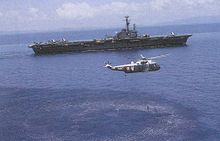
The dramatic change in the Indian Navy's capabilities and stance was emphatically demonstrated during the Indo-Pakistani War of 1971. Under the command of Admiral Sardarilal Mathradas Nanda, the navy successfully enforced a naval blockade of West and East Pakistan.[53] Pakistan's lone long-range submarine PNS Ghazi was sunk following an attack by the destroyer INS Rajput off the coast of Visakhapatnam in the midnight of 3–4 December 1971.[54][55] On 4 December, the Indian Navy successfully executed Operation Trident, a devastating attack on the Pakistan Naval Headquarters of Karachi that sank a minesweeper, a destroyer and an ammunition supply ship. The attack also irreparably damaged another destroyer and oil storage tanks at the Karachi port.[56] To commemorate this, 4 December is celebrated as the Navy Day.[57] This was followed by Operation Python on 8 December 1971, further deprecating the Pakistan Navy's capabilities.[56] Indian frigate INS Khukri, commanded by Captain M. N. Mulla was sunk by PNS Hangor, while INS Kirpan was damaged on the west coast.[58] In the Bay of Bengal, the aircraft carrier INS Vikrant was deployed to successfully enforce the naval blockade on East Pakistan. Sea Hawk and the Alizé aircraft from INS Vikrant sank numerous gunboats and Pakistani merchant marine ships.[59] To demonstrate its solidarity as an ally of Pakistan, the United States sent Task Force 74 centred around the aircraft carrier USS Enterprise into the Bay of Bengal. In retaliation, Soviet Navy submarines trailed the American task force, which moved away from the Indian Ocean towards Southeast Asia to avert a confrontation.[60] In the end, the Indian naval blockade of Pakistan choked off the supply of reinforcements to the Pakistani forces, which proved to be decisive in the overwhelming defeat of Pakistan.[61]
Since playing a decisive role in the victory, the navy has been a deterrent force maintaining peace for India in a region of turmoil. In 1983, the Indian Navy planned for Operation Lal Dora to support the government of Mauritius against a feared coup.[62] In 1986, in Operation Flowers are Blooming, the Indian Navy averted an attempted coup in the Seychelles.[63] In 1988, India launched Operation Cactus, to successfully thwart a coup d'état by PLOTE in the Maldives. Naval maritime reconnaissance aircraft detected the ship hijacked by PLOTE rebels. INS Godavari and Indian marine commandos recaptured the ship and arrested the rebels.[64] During the 1999 Kargil War, the Western and Eastern fleets were deployed in the Northern Arabian Sea, as a part of Operation Talwar.[65] They safeguarded India's maritime assets from a potential Pakistani naval attack, and also deterred Pakistan from attempting to block India's sea-trade routes.[66] The Indian Navy's aviators flew sorties and marine commandos fought alongside Indian Army personnel in the Himalayas.[67]
In October 1999, the Navy along with the Indian Coast Guard rescued MV Alondra Rainbow, a pirated Japanese cargo ship.[68]
21st century onwards


In the 21st century, the Indian Navy has played an important role in maintaining peace for India on the maritime front, in spite of the state of foment in its neighbourhood. It has been deployed for humanitarian relief in times of natural disasters and crises across the globe, as well as to keep India's maritime trade routes free and open.[69]
The Indian Navy was a part of the joint forces exercises, Operation Parakram, during the 2001–2002 India–Pakistan standoff. More than a dozen warships were deployed to the northern Arabian Sea.[70] In October, the Indian Navy took over operations to secure the Strait of Malacca, to relieve US Navy resources for Operation Enduring Freedom.[71]
The navy plays an important role in providing humanitarian relief in times of natural disasters, including floods, cyclones and tsunamis. In the aftermath of the 2004 Indian Ocean earthquake and tsunami, the Indian Navy launched massive disaster relief operations to help affected Indian states as well as Maldives, Sri Lanka and Indonesia. Over 27 ships, dozens of helicopters, at least six fixed-wing aircraft and over 5000 personnel of the navy were deployed in relief operations.[72] These included Operation Madad in Andhra Pradesh and Tamil Nadu, Operation Sea Waves in the Andaman and Nicobar Islands, Operation Castor in Maldives, Operation Rainbow in Sri Lanka and Operation Gambhir in Indonesia.[73] Gambhir, carried out following the 2004 Indian Ocean tsunami, was one of the largest and fastest force mobilisations that the Indian Navy has undertaken. Indian naval rescue vessels and teams reached neighbouring countries less than 12 hours from the time that the tsunami hit.[74] Lessons from the response led to decision to enhance amphibious force capabilities, including the acquisition of landing platform docks such as INS Jalashwa, as well as smaller amphibious vessels.[75]

During the 2006 Israel-Lebanon conflict, the Indian Navy launched Operation Sukoon and evacuated 2,280 persons from 20 to 29 July 2006 including 436 Sri Lankans, 69 Nepalese and 7 Lebanese nationals from war-torn Lebanon.[76][77] In 2006, Indian naval doctors served for 102 days on board USNS Mercy to conduct medical camps in the Philippines, Bangladesh, Indonesia and East Timor.[78] In 2007, Indian Navy supported relief operations for the survivors of Cyclone Sidr in Bangladesh.[79] In 2008, Indian Naval vessels were the first to launch international relief operations for victims of Cyclone Nargis in Myanmar.[80][81] In 2008, the navy deployed INS Tabar and INS Mysore into the Gulf of Aden to combat piracy in Somalia.[82] Tabar prevented numerous piracy attempts, and escorted hundreds of ships safely through the pirate-infested waters.[83] The navy also undertook anti-piracy patrols near the Seychelles, upon that country's request.[84][85]
In February 2011, the Indian Navy launched Operation Safe Homecoming and rescued Indian nationals from war torn Libya.[86] Between January–March, the navy launched Operation Island Watch to deter piracy attempts by Somali pirates off the Lakshadweep archipelago. This operation has had numerous successes in preventing pirate attacks.[87][88][89] During the 2015 crisis in Yemen, the Indian Navy was part of Operation Raahat and rescued 3074 individuals of which 1291 were foreign nationals.[90] On 15 April 2016, a Poseidon-8I long-range patrol aircraft managed to thwart a piracy attack on the high seas by flying over MV Sezai Selaha, a merchant vessel, which was being targeted by a pirate mother ship and two skiffs around 800 nautical miles (1,500 km; 920 mi) from Mumbai.[91]
India enacted its first domestic anti-piracy legislation as the Maritime Anti-Piracy Act 2022, on 20 December, 2022 criminalizing maritime piracy and empowering the Indian Navy and other government agencies with the authority to respond to threats at sea.[92] In 2024, Chief Admiral R. Hari Kumar referred to the new law as a "great enabler" in the navy's anti-piracy success.[93] That year, The Economic Times referred to the Indian Navy's commitment in combating maritime piracy as "unwavering".[94]
In January 2024, the Indian Navy deployed over 10 warships under Operation Sankalp to protect commercial shipping in the Gulf of Aden and the Arabian Sea in the wake of Houthi-led attacks on merchant vessels. Some of the ships deployed included guided missile destroyers like the INS Kolkata, INS Kochi, INS Chennai and INS Mormugao, as well as frigates like the INS Talwar and INS Tarkash. On 5 January, the INS Chennai prevented the hijacking of the Liberian merchant vessel MV Lila Norfolk. Although India declined to join the multinational US-led Operation Prosperity Guardian, the Indian Navy continued to share information and coordinate operations with the United States, United Kingdom, and France.[95]
In May 2024, the Navy officially replaced the terms "Jack" and "Jackstaff" with "National Flag" and "National Flag Staff". The words Jack and Jackstaff orignates from the Royal Navy's traditions which implies for national flag and the short pole on the bow of the ship to host the flag in 'naval parlance', respectively.[96]
Current role

The principal roles of the Indian Navy are:[97][98]
- In conjunction with other Armed Forces of the Union, act to deter or defeat any threats or aggression against the territory, people or maritime interests of India, both in war and peace;
- Project influence in India's maritime area of interest, to further the nation's political, economic and security objectives;
- In co-operation with the Indian Coast Guard, ensure good order and stability in India's maritime zones of responsibility.
- Provide maritime assistance (including disaster relief) in India's maritime neighbourhood.
Command and organisation
Organisation
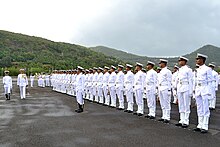
While the President of India serves as the Supreme Commander of the Indian Armed Forces, the organisational structure of the Indian Navy is headed by the Chief of Naval Staff (CNS), who holds the rank of Admiral.[99] While the provision for the rank of Admiral of the Fleet exists, no officer of the Indian Navy has yet been conferred this rank.[100] The CNS is assisted by the Vice Chief of Naval Staff (VCNS), a Vice Admiral; the CNS also heads the Integrated Headquarters (IHQ) of the Ministry of Defence (Navy), based in New Delhi. The Deputy Chief of Naval Staff (DCNS), a vice-admiral, is a Principal Staff Officer (PSO), along with the Chief of Personnel (COP) and the Chief of Materiel (COM), both of whom are also vice-admirals.[99] The Director General Medical Services (Navy) is a Surgeon Vice-Admiral, heads the medical services of the Indian Navy.[101]
The Indian Navy operates three operational commands and one training command. Each command is headed by a Flag Officer Commanding-in-Chief (FOC-in-C) of the rank of Vice Admiral.[102] The Eastern, Western and Southern commands each have a Fleet commanded by a Rear Admiral. The Western Fleet based at Mumbai is commanded by the Flag Officer Commanding Western Fleet (FOCWF), the Eastern Fleet, based at Visakhapatnam, is commanded by the Flag Officer Commanding Eastern Fleet (FOCEF) and the Southern Command, based at Kochi, is commanded by the Flag Officer Commanding Southern Fleet (FOCSF). They each also have a Commodore commanding submarines (COMCOS) - the Commodore Commanding Submarines (East) and the Commodore Commanding Submarines (West).[103] The Flag Officer Submarines, the single-point class authority for submarines is based at the Eastern Naval Command. The Southern Naval Command is home to the Flag Officer Sea Training (FOST).[104]
Additionally, the Andaman and Nicobar Command is a unified Indian Navy, Indian Army, Indian Air Force, and Indian Coast Guard theater command based at the capital, Port Blair.[105] Commander-in-Chief, Andaman and Nicobar Command (CINCAN) receives staff support from, and reports directly to the Chairman Chiefs of Staff Committee (COSC) in New Delhi. The Command was set up in the Andaman and Nicobar Islands in 2001.[106]
| Post | Location | Current Holder |
|---|---|---|
| Chief of the Naval Staff | New Delhi | Admiral Dinesh K Tripathi, PVSM, AVSM, NM[109] |
| Vice Chief of the Naval Staff | Vice Admiral Krishna Swaminathan, AVSM, VSM[110] | |
| Deputy Chief of the Naval Staff | Vice Admiral Tarun Sobti, AVSM, VSM[111] | |
| Chief of Personnel | Vice Admiral Sanjay Bhalla, AVSM, NM[112] | |
| Chief of Materiel | Vice Admiral Kiran Deshmukh, AVSM, VSM[113] | |
| Commands | HQ Location | Current FOC-in-C |
| Western Naval Command | Mumbai | Vice Admiral Sanjay Jasjit Singh, AVSM, NM[114] |
| Eastern Naval Command | Visakhapatnam | Vice Admiral Rajesh Pendharkar, AVSM, VSM[115] |
| Southern Naval Command | Kochi | Vice Admiral Vennam Srinivas, AVSM, NM[116] |
Facilities

Indian Navy has its operational and training bases in Gujarat, Karnataka, Goa, Maharashtra, Lakshadweep, Kerala, Odisha, Tamil Nadu, Andhra Pradesh, West Bengal, and Andaman and Nicobar Islands. These bases are intended for various purposes such as logistics and maintenance support, ammunition support, air stations, hospitals, MARCOS bases, coastal defence, missile defence, submarine and missile boat bases, forward operating bases etc.[117][118][119] Of these, INS Shivaji is one of the oldest naval bases in India. Commissioned in February 1945 as HMIS Shivaji, it now serves as the premier Technical Training Establishment (TTE) of the Indian Navy.[120]
In May 2005, the Indian Navy commissioned INS Kadamba at Karwar, 100 kilometres (62 mi) from Goa.[121] Built under the first phase of the Project Seabird, at first it was an exclusively Navy controlled base without sharing port facilities with commercial shipping.[122] The Indian Navy also has berthing rights in Oman and Vietnam.[123] The Navy operates a monitoring station, fitted with radars and surveillance gear to intercept maritime communication, in Madagascar. It also plans to build a further 32 radar stations in Seychelles, Mauritius, Maldives and Sri Lanka.[124] According to Intelligence Online, published by a France-based global intelligence gathering organisation, Indigo Publications, the Navy is believed to be operating a listening post in Ras al-Hadd, Oman. The post is located directly across from Gwadar Port in Balochistan, Pakistan, separated by approximately 400 kilometres (250 mi) of the Arabian Sea.[125]
The navy operates INS Kattabomman, a VLF and ELF transmission facility at Vijayanarayanapuram near Tirunelveli in Tamil Nadu.[126] INS Abhimanyu and INS Karna are two bases dedicated for MARCOS.[127][128] Project Varsha is a highly classified project undertaken by the Navy to construct a hi-tech base under the Eastern Naval Command. The base is said to house nuclear submarines and also a VLF facility.[129][130]
Training
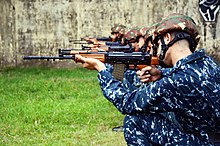
Indian Navy has a specialized training command which is responsible for organisation, conduct and overseeing of all basic, professional and specialist training throughout the Navy. The Commander in Chief of Southern Command also serves as the Commander in Chief of Training Command. The Chief of Personnel (CoP) at HQ of Indian Navy is responsible for the framework of training, and exercises the responsibility through Directorate of Naval Training (DNT).[131] The training year of Indian Navy is defined from 1 July to 30 June of the following year.[132]
Seaman training is held at INS Chilika, Orissa.
Officer training is conducted at Indian Naval Academy (INA) at Ezhimala, on the coast of Kerala. Established in 2009, it is the largest naval academy in Asia. Cadets from National Defence Academy also move to INA for their later terms.[133] The Navy also has specialized training establishments for gunnery, aviation, leadership, logistics, music, medicine, physical training, educational training, engineering, hydrography, submarines etc. at several naval bases[134] along the coastline of India.[135] Naval officers also attend the tri-service institutions National Defence College, College of Defence Management and Defence Services Staff College for various staff courses to higher command and staff appointments. The Navy's War college is the Naval War College, Goa.[131] A dedicated wing for naval architecture under Directorate of Naval Architecture at IIT Delhi is operated by the Navy.[136] Indian Navy also trains officers and men from the navies of friendly foreign countries.[132]
Rank structure
As of 1 July 2017[update], the Navy has 10,393 officers and 56,835 sailors against a sanctioned strength of 11,827 officers and 71,656 sailors.[137] This is inclusive of naval aviation, marine commandos and Sagar Prahari Bal personnel.[138]
Officers
India uses the Midshipman rank in its navy, and all future officers carry the rank upon entering the Indian Naval Academy. They are commissioned Sub-lieutenants upon finishing their course of study.[139][140]
While the provision for the rank of Admiral of the Fleet exists, it is primarily intended for major wartime use and honour. No officer of the Indian Navy has yet been conferred this rank. Both the Army and Air Force have had officers who have been conferred with the equivalent rank – Field Marshals Sam Manekshaw and Cariappa of the Army and Marshal of the Indian Air Force (MIAF) Arjan Singh.[100]
The highest ranked naval officer in organisation structure is the Chief of Naval Staff, who holds the rank of admiral.[140]
| Rank group | General / flag officers | Senior officers | Junior officers | Officer cadet | ||||||||||||||||||||||||||||||||
|---|---|---|---|---|---|---|---|---|---|---|---|---|---|---|---|---|---|---|---|---|---|---|---|---|---|---|---|---|---|---|---|---|---|---|---|---|
 
|
 
|
 
|

|

|

|

|

|

|

| |||||||||||||||||||||||||||
| Admiral एडमिरल |
Vice admiral वाइस एडमिरल |
Rear admiral रियर एडमिरल |
Commodore कमोडोर |
Captain कैप्टन |
Commander कमांडर |
Lieutenant commander लेफ़्टिनेंट कमांडर |
Lieutenant लेफ्टिनेंट |
Sub-lieutenant सब लेफ्टिनेंट |
Midshipman मिडशिपमैन | |||||||||||||||||||||||||||
Rating personnel
In the Indian Navy, the sailors are initially listed as, Seaman 2nd class. As they grow through the ranks they attain the highest rank of enlisted personnel, Master chief petty officer 1st class. Sailors who possess leadership qualities and fulfill requisite conditions in terms of education, age etc. may be commissioned through Commission worthy and Special Duties (CW & SD) scheme.[139]







